Putignano
Updated at: 01-12-2024
How this content can help you:
- You will discover the Memory Festival of Putignano, dedicated to historical reflection and cultural preservation.
- You will learn about the Carnival of Putignano, one of the oldest in Europe, and its importance to the community.
- You will listen to local testimonies that tell stories and anecdotes of everyday life.
- You will explore the main attractions, such as the Trullo Cave and the historic center.
- You will savor the local cuisine, including farinella and capocollo.
- You will receive practical advice for visiting Putignano at the best time.
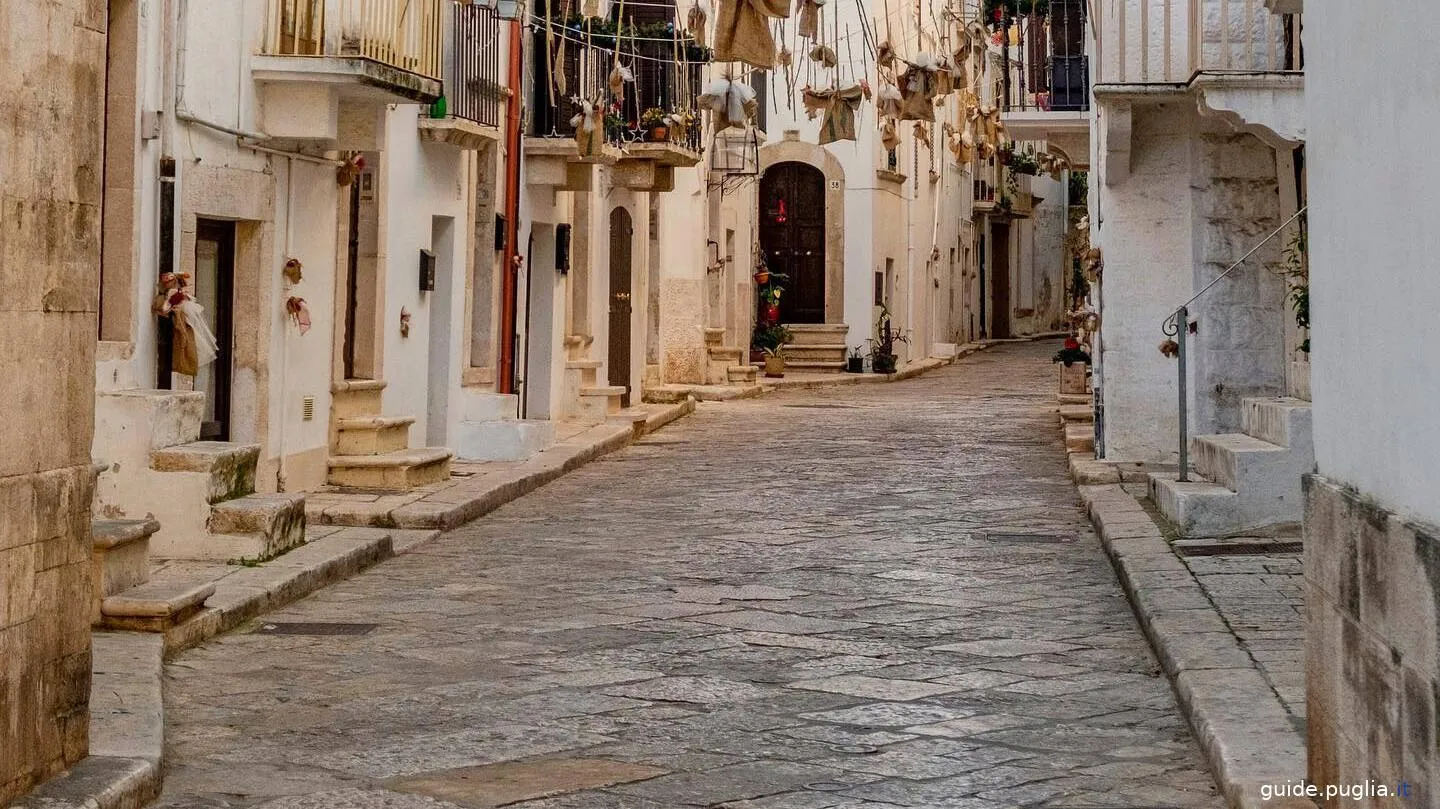
In the heart of Puglia, less than 40 km from the lively city of Bari, lies Putignano, a place that enchants visitors and scholars with its rich history and vibrant cultural traditions. This Italian town stands on three hills, about 375 meters above sea level, offering a breathtaking panorama of the surrounding region characterized by vast countryside and imposing karst formations.
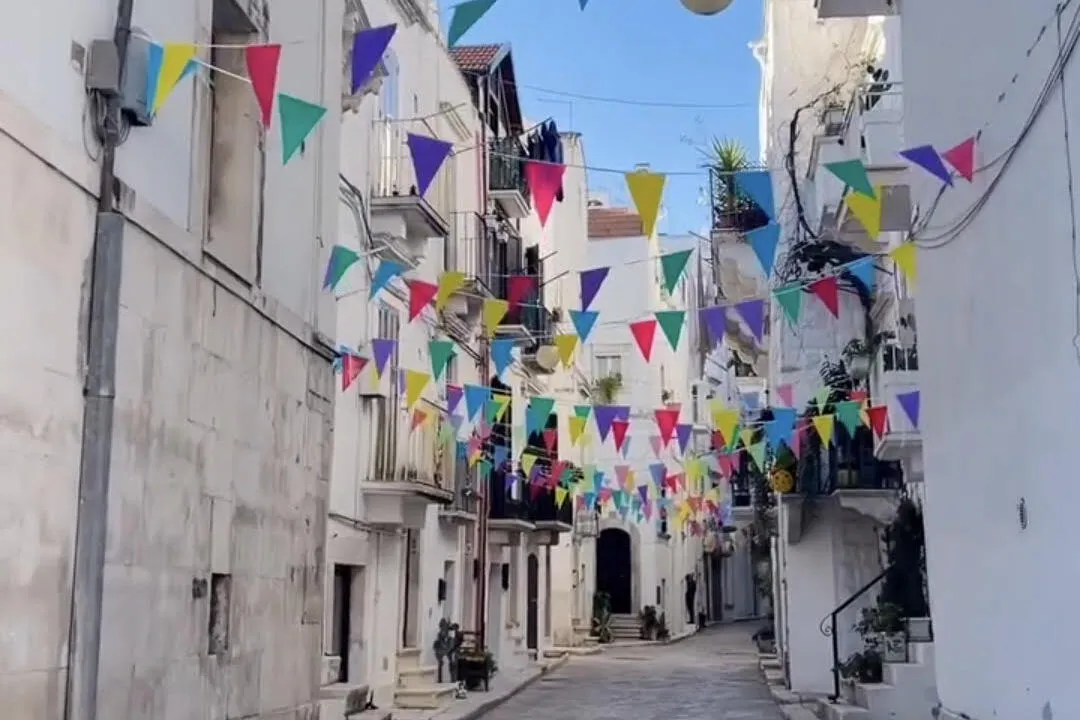
Putignano is famous for its historic Carnival, recognized as one of the oldest in Europe. This celebration, which has roots in medieval times, transforms the town into an open-air stage where masks, floats, and folk performances succeed each other in a lively tribute to local traditions. The Carnival of Putignano is not just a festival, but a symbol of cultural resilience and revival, an unmissable event that attracts thousands of visitors from all over the world every year.
Putignano's historical significance goes beyond its famous carnival. The origins of the town date back to ancient times, with evidence showing it was populated already in the Peucetian era before the arrival of the Romans. Over the centuries, Putignano has seen various dominations, from Byzantine to Norman influences, each leaving an indelible mark on the town's urban structure and cultural fabric. Religious architectures, such as the Church of Saint Peter the Apostle, and numerous karst caves like the Trullo Cave, testify to the historical and natural complexity of this fascinating location.
Exploring Putignano reveals not only traces of its glorious past but also the image of a community looking to the future, proudly preserving its cultural heritage and actively promoting its assets within the regional and international tourist scene. Putignano is an eloquent example of how history and modernity can coexist harmoniously, offering its residents and visitors a place rich in beauty, tradition, and innovation.
History of Putignano
The history of Putignano unfolds over millennia, an enthralling journey tracing the transformations of this town from its inception to the present day. Its origins are shrouded in the mists of time, with the earliest human settlements dating back to the Peucetian era, an Illyrian tribe that occupied the region before Greek and later Roman colonization. During the era of Magna Graecia, Putignano was a flourishing agricultural center, exploiting its strategic position in the fertile lands of the Murgia.
With the advent of Roman rule, the town was integrated into the road network of the Empire, further fostering economic and cultural development. Archaeological evidence, including pottery, coins, and tools, indicates a period of relative prosperity and stability. The Roman era left an indelible mark on Putignano's urban planning and architecture, with infrastructures that partially survive to this day.
The Middle Ages were a crucial period in Putignano's history, marked by continuous political and social changes. During this time, the town came under the control of various feudal lords and was often at the center of conflicts and territorial disputes. Despite the turmoil, Putignano continued to develop, and in the 14th century, it became known for its carnival, originally a pagan festival that transformed into a religious event with the translation of Saint Stephen's relics.
The Renaissance era saw Putignano grow as a center of culture and art. During this period, the town was significantly influenced by the humanistic and Renaissance currents sweeping through Italy. The construction of churches and palaces in Renaissance style enriched the town's architectural heritage, evidenced today by the Church of Saint Peter the Apostle, a gem of local Renaissance art.
The modern era marked another important chapter for Putignano, with the development of the textile industry and commerce. The town established itself as an important center for clothing production, especially wedding dresses and children's wear, a sector that continues to influence the local economy. Additionally, agriculture remained a vital component of Putignano's economy, with the cultivation of artichokes and other vegetables celebrated in various local gastronomic events.
Throughout the ages, Putignano has always maintained a close connection to its historical and cultural roots, while embracing change and innovation. This adaptability is evident not only in its economy and cultural practices but also in the urban structure, which has skillfully integrated modern elements with those of a distant past.
The Carnival of Putignano

One of the most vibrant and colorful expressions of Putignano's culture is undoubtedly the Carnival of Putignano, known for being one of the oldest and longest carnivals in Europe. This event has deep roots that intertwine closely with local history and traditions, making it an essential event to fully understand the spirit and identity of the town.
The Carnival of Putignano officially begins on December 26th, Saint Stephen's Day, with the "Propaggini" ceremony, where citizens start celebrating with satirical songs in the Putignanese dialect. This tradition dates back to 1394, when the saint's body was transferred from Monopoli to Putignano, and the peasants, taking advantage of the occasion, indulged in celebrations and mockeries towards the feudal lords.
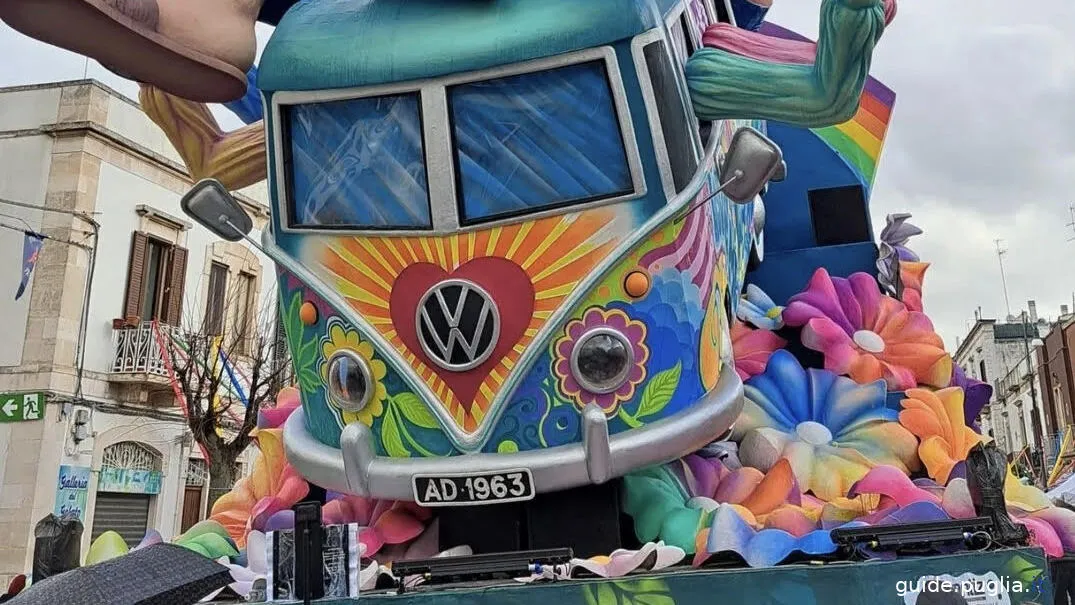
The climax of the carnival occurs in the period leading up to Shrove Tuesday, when the town transforms into an open-air theater with parades of gigantic papier-mâché floats. These floats are the result of months of hard work by local artisans, true masters of papier-mâché art, who sculpt spectacular and sometimes irreverent figures satirizing current events, politics, and popular culture. Each float is an intricate work of art that engages and fascinates both visitors and residents.
The costumes worn during the parades are equally elaborate and colorful, representing a variety of themes ranging from the fantastic to the folkloric. A recurring character is Farinella, a local harlequin, whose costume is richly decorated and embodies the playful and mischievous spirit of the carnival. Farinella is named after a typical Putignano dish and symbolizes the joy and irreverence that pervades the town during the carnival period.
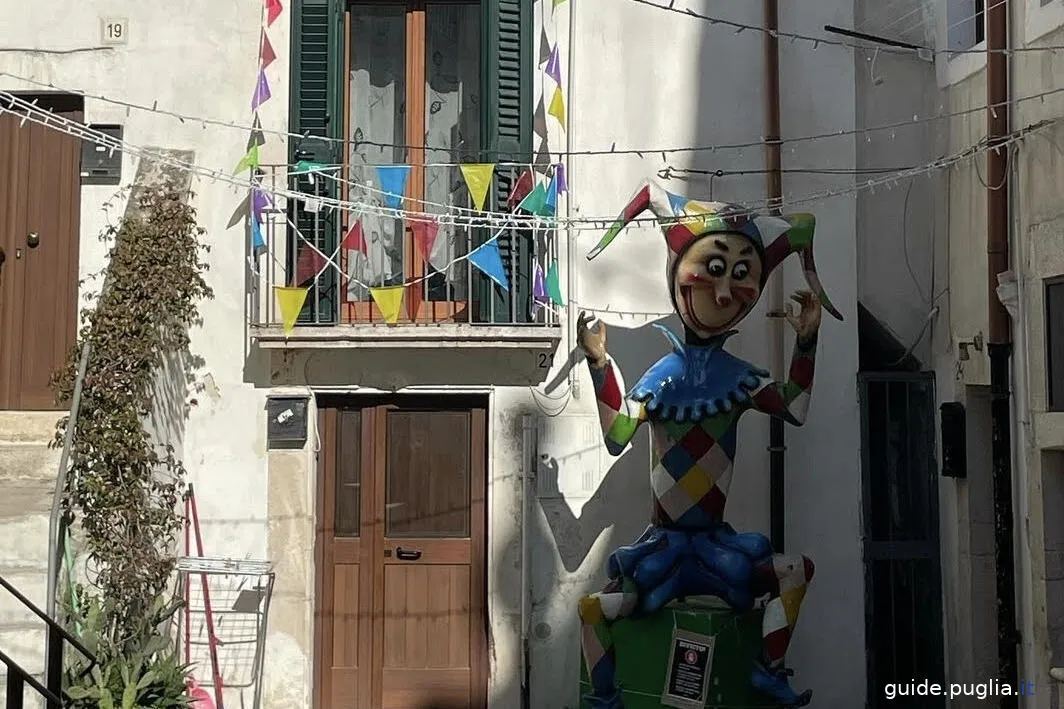
Beyond its playful and spectacular aspect, the Carnival of Putignano plays a crucial role in the cultural life of the town. It is a moment of strong community cohesion, an opportunity to reinforce local identity and pass on traditions to new generations. The parades and festivities attract thousands of visitors each year, boosting the local economy and promoting Putignano nationally and internationally.
The importance of the Carnival of Putignano is recognized even beyond local boundaries, becoming a symbol of creativity and cultural resilience. It reflects the skill of Putignano's artisans and their ability to reinterpret reality with irony and mastery, elements that make this carnival a unique event in the Italian and European panorama.
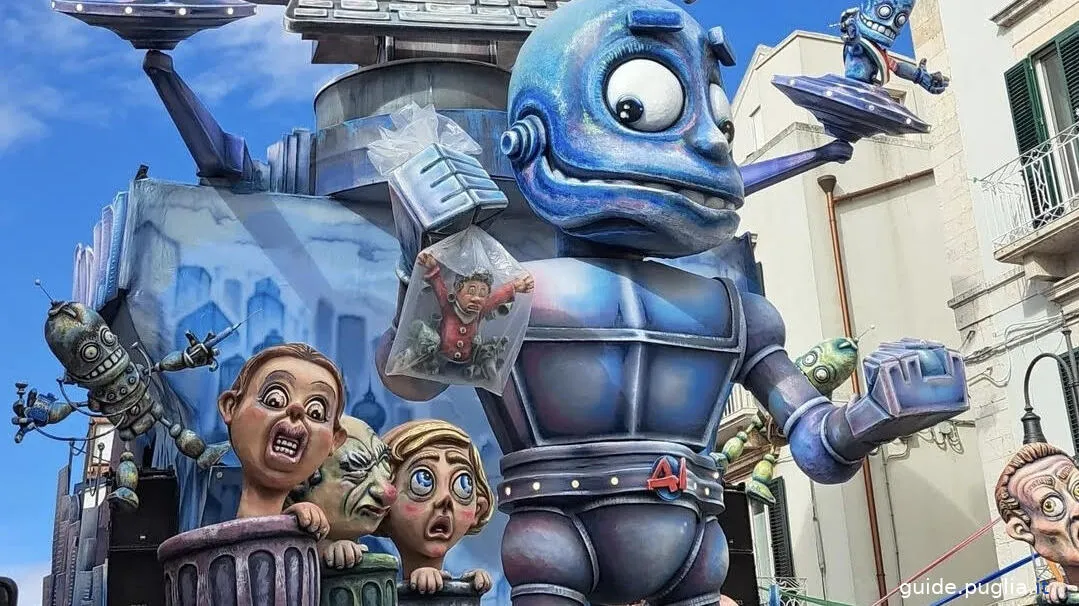
The Carnival of Putignano is not just a festival but a living heritage that continues to evolve while remaining true to its roots. The event offers a snapshot of Putignano's social and cultural life, making the town a shining example of how traditions can adapt and thrive in modern times.
Main Attractions and Tourism
While the Carnival of Putignano is undoubtedly one of the most lively moments of the year, the town offers a treasure trove of attractions that captivate visitors throughout all seasons. Located in the wonderful region of Puglia, Putignano is a destination that fascinates not only for its festivities but also for its rich cultural and natural offerings.
The Trullo Cave is a must-see for anyone visiting Putignano.
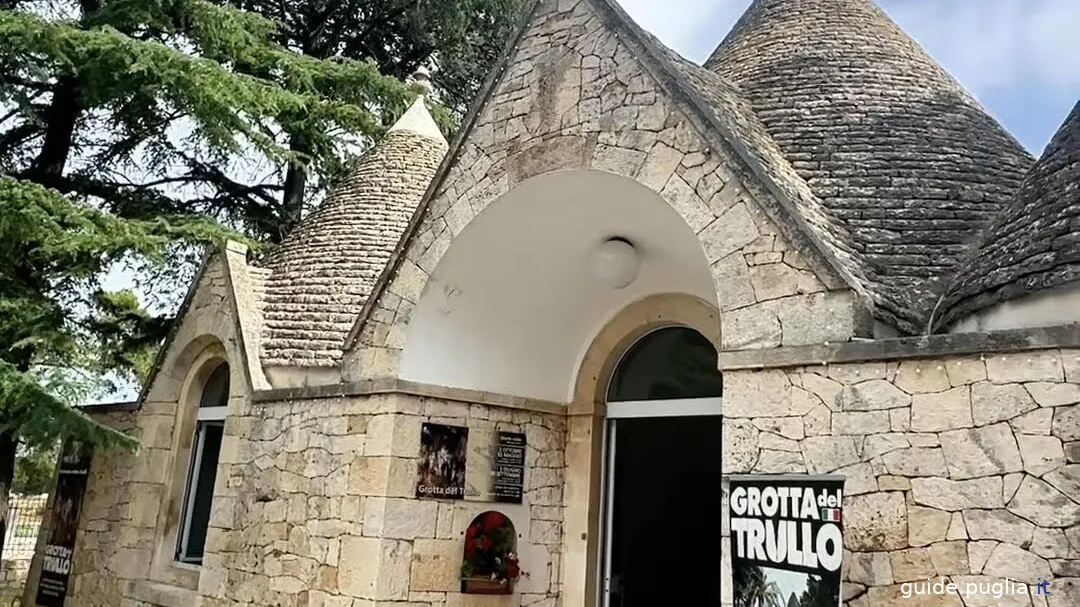
This karst cave, discovered in the 19th century, is known for its stunning stalactite and stalagmite formations. Guided tours offer the opportunity to explore an underground world of incredible beauty, illuminated to highlight the various shapes and colors of the rocks. It is an experience that combines adventure and discovery, suitable for both adults and children.
Continuing the discovery of historical and cultural heritage, the Historic Center of Putignano invites a journey back in time with its cobbled streets, baroque churches, and ancient mansions. Walking through the alleys, one encounters stone arches and flowered balconies, as well as numerous artisan workshops that keep local traditions alive. Among these, weaving and ceramic workshops offer an interesting insight into the activities that have made Putignano famous in the Italian artisan panorama.
Another essential stop is the Church of Saint Peter the Apostle, a jewel of religious architecture, whose imposing entrance portal and richly decorated interiors tell stories of faith and art. The church often hosts classical music concerts, taking advantage of the building's excellent acoustics.
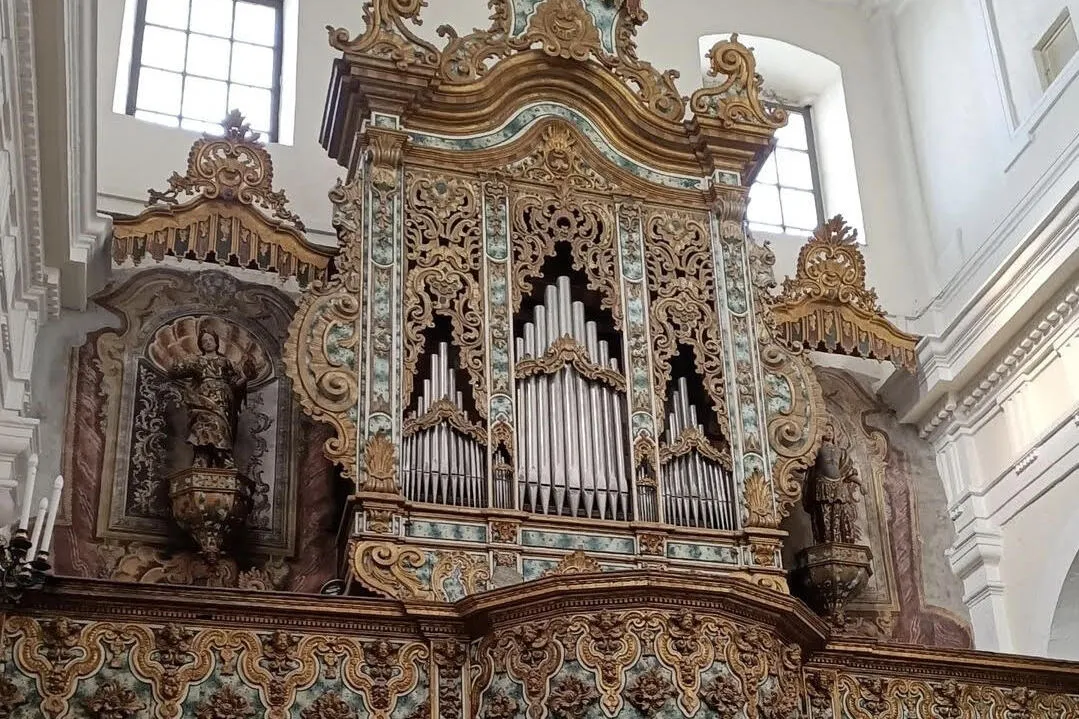
For nature lovers, the Sacred Cave of Saint Michael the Archangel in Monte Laureto offers not only natural beauty but also a place of spiritual significance. This cave is an important pilgrimage site, where the tranquility of the natural environment combines with historical and religious depth.
The proximity to famous places like Alberobello, renowned for its trulli, further enhances Putignano's tourist possibilities. A short excursion can turn into an immersion in UNESCO heritage, allowing visitors to combine a visit to Putignano with a wide exploration of Puglia's wonders.
Tourists who wish to explore Putignano are advised to take their time wandering leisurely through the historic center, book guided tours of the caves in advance, and check out the cultural events that frequently enliven the town, such as art exhibitions, theater performances, and music festivals. Additionally, it is advisable to visit Putignano during the Carnival period to fully experience the cultural vibrancy that characterizes this local festival.
These attractions, combined with the warm hospitality of the Putignanesi, make the town a fascinating destination for those seeking to discover the traditions, history, and natural beauty of Puglia. With every corner rich in history and every street capable of telling a story, Putignano promises unforgettable experiences to all its visitors.
You can learn more about what to do and see in Putignano in the post: What to do and see in Putignano
Local Gastronomy
A culinary journey through Putignano will offer visitors not only a taste of local traditions but also a true immersion in Puglian culture. Putignano's cuisine is an explosion of flavors, colors, and aromas that reflect the abundance and variety of the region's agricultural products.
One of the most characteristic and celebrated dishes is farinella, an ancient product that appears as a very fine flour obtained from grinding roasted chickpeas and barley. Traditionally consumed as a staple food by the working classes for its high energy content and ease of preparation, today farinella is appreciated for its unique taste and can be enjoyed in various ways: sprinkled on salads, used as a seasoning for hot dishes, or even savored on its own, perhaps accompanied by a glass of local wine.
Another highlight of Putignano's gastronomy is olive oil. The surrounding hills are rich with olive groves, and the oil produced here is known for its fruity and slightly spicy flavor, ideal for dressing salads or enhancing the taste of vegetable-based dishes.
Putignano's connection to meat is evidenced by the preparation of capocollo from Martina Franca, a salami seasoned with black pepper, red wine, and aromatic herbs, typical of the area. This salami stands out for its sweetness and soft texture, the result of a long aging process.
Visitors cannot leave Putignano without tasting taralli, small crunchy snacks made from flour, olive oil, salt, and white wine. Available in different varieties, some enriched with fennel seeds, others with black pepper or chili pepper, taralli are perfect to accompany an aperitif or simply as a snack during the day.
Regarding the choice of restaurants where to try these and other delicious dishes, Putignano offers numerous options. La Locanda del Macellaio is one of the most appreciated addresses, known for its excellent meats and a welcoming atmosphere that combines rusticity and elegance. Here, visitors can order the famous capocollo accompanied by an assortment of local appetizers.
Osteria Tranquillo offers a menu that celebrates local products with simple but flavorful dishes, such as homemade orecchiette served with turnip tops or fresh tomato and basil sauce. The restaurant, with its family atmosphere, is a must-visit for those who want to immerse themselves in the authentic flavors of Puglian cuisine.
For a more innovative culinary experience, Ristorante Al Gambero presents a cuisine that reinterprets traditional recipes in a modern key, using seasonal ingredients directly from local producers. Their wine list, focused on Puglian grape varieties, is the cherry on top of a memorable culinary experience.
These examples represent just a part of Putignano's culinary riches. Every dish tells a story, every bite is a journey through the history and culture of this fascinating corner of Italy. Visiting its restaurants, trying the typical dishes, and talking with the locals offers tourists a profound and authentic way to understand and experience Putignano, not just as visitors but as true participants in the life of the town.
Cultural Life and Events
Putignano's cultural scene is lively and vibrant, with a calendar of events that offers an extraordinary variety of manifestations for all tastes and ages. These events not only celebrate the place's historical roots and traditions but also stimulate the local community and attract visitors from other parts of Italy and the world.
At the top of the list of must-see events is undoubtedly the Carnival of Putignano, one of the oldest and longest in Europe. Starting the day after Saint Stephen's Day and culminating on Shrove Tuesday, the Carnival of Putignano transforms the entire town into a colorful stage. During this period, the streets fill with parades, allegorical floats, and traditional masks, representing an art form passed down from generation to generation. Besides its importance as a popular festival, this event is a catalyst for economic activities and a showcase of local creativity.
Another event of great cultural relevance is the Feast of Saint Joseph, celebrated every year on March 19th. During this festival, Putignano families prepare the traditional "Saint Joseph's tables," setting up banquets offering a variety of typical dishes blessed in the town's main church. This celebration, deeply rooted in the community, is an opportunity to gather, renew family and social ties, and pay homage to the patron saint of carpenters, thereby strengthening collective identity.
In spring, Putignano further comes to life with the Spring Festival, an event that marks the awakening of nature and stimulates citizen participation through ecological initiatives, local craft markets, and outdoor concerts. This festival not only celebrates the season but also promotes environmental awareness and sustainability, demonstrating the town's commitment to a greener future.
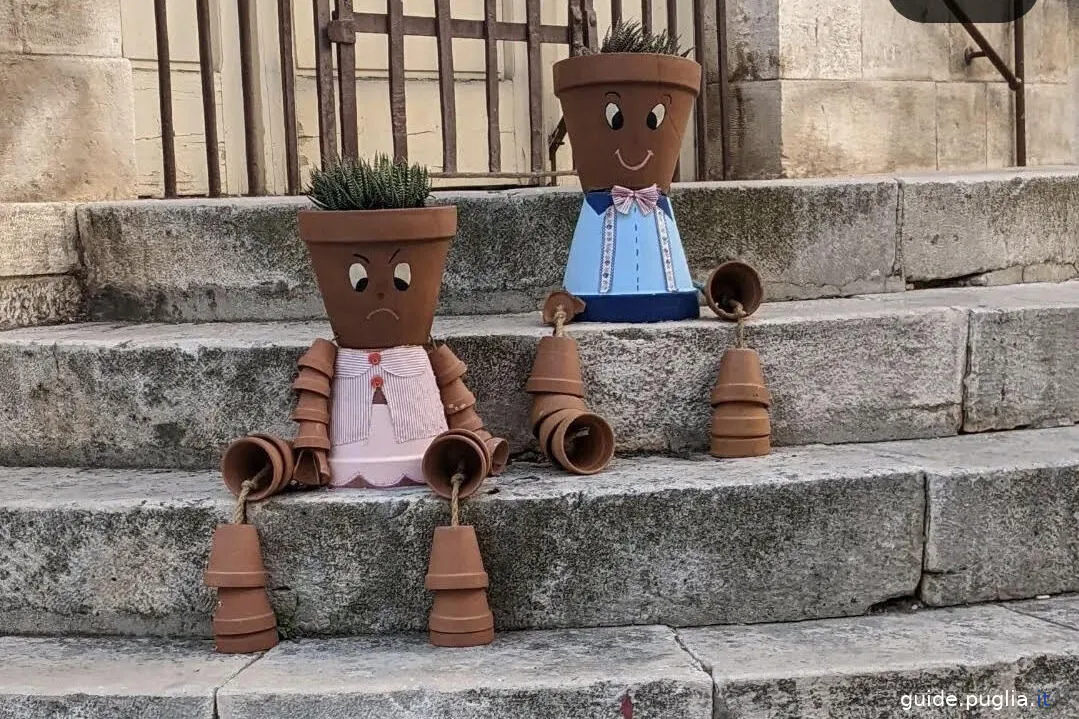
During the summer, the Putignano Jazz Festival attracts music enthusiasts from all over the country. Internationally renowned artists and emerging talents perform in a series of concerts held in the town's historic squares, creating a unique atmosphere where music and cultural heritage merge. This event not only enriches the town's cultural offerings but also helps keep the jazz tradition alive in the Puglia region.
In November, Putignano celebrates the Memory Festival, dedicated to historical reflection and cultural heritage preservation. Conferences, exhibitions, and workshops attract scholars, students, and the curious, focusing on the themes of historical memory and the role of storytelling in shaping society. This festival is crucial for promoting intergenerational dialogue and reflecting on local history in the broader context of Italian cultural and historical movements.
Through these and many other events, Putignano demonstrates a constant commitment to promoting culture and enriching its citizens' social life. The variety and quality of cultural events offered reflect the vibrancy of this community and its desire to share its cultural heritage with the outside world, profoundly influencing daily life and strengthening local pride and sense of belonging.
Local Testimonies and Anecdotes
To authentically get to the heart of Putignano, it's essential to listen to its inhabitants' voices, who, with their daily stories and anecdotes, add color and depth to the town's narrative. Through interviews and informal conversations, a vivid and personal fresco emerges, allowing one to understand not only the history but also the present and the hopes for this community's future.
Giulia, an elderly lady who runs a small shop of typical products in the historic center, recounts: "Putignano has always had a lively soul. As a young girl, I remember the streets always full of people, especially during Carnival. Everything changed color, and we children couldn't wait to wear the masks my father made by hand." This connection to the Carnival tradition often emerges in conversations, underscoring how the event is deeply woven into the town's social and cultural fabric.
Marco, an artisan who works with local stone, offers a perspective on change: "The techniques I use are the same ones my grandfather taught me, but today there's less demand for traditional manual work. However, I find that there's a new appreciation for authentic craftsmanship, especially among tourists looking for something unique to take home." The resilience and adaptability of local artisans like Marco illustrate how Putignano is navigating the delicate balance between modernization and preserving its roots.
Antonia, a young elementary school teacher, talks about the importance of education in preserving local culture: "I teach my students songs and stories I learned from my grandparents. It's crucial for the new generation to understand where they come from to build a future that respects our history." Education thus emerges as a fundamental pillar in transmitting and preserving Putignano's cultural traditions.
Luca, a restaurant owner, reflects on the evolution of local cuisine: "Farinella and our artichoke-based dishes have always been at the heart of Putignano's cuisine. But now we're experimenting, combining traditional flavors with modern techniques to create something new and exciting." This culinary innovation represents a broader trend in the town, where respect for the past blends with openness to new possibilities.
These life fragments, collected from residents' voices, offer an intimate and multifaceted view of Putignano. It's not just about knowing places and events, but feeling the town's heartbeat through the experiences of those who live it every day. The stories of Giulia, Marco, Antonia, and Luca are not just personal testimonies but living chapters of a collective narrative that continues to evolve with each generation.
Conclusions and Recommendations for Visitors
Visiting Putignano offers a unique cultural experience, enriched by a deeply rooted history, a lively event calendar, and irresistible gastronomy. For those planning a trip to this enchanting town in Puglia, here are some practical tips to maximize their experience.
Firstly, the best time to visit Putignano is undoubtedly during Carnival, which starts on December 26th and continues until Shrove Tuesday. During this time, the town transforms with parades of papier-mâché floats and colorful masks offering an unparalleled spectacle. Ensure to book your stay well in advance, as this is a high season for the town.
For history and architecture enthusiasts, visiting in the spring or fall is ideal. The mild climate during these months makes walks through the historic center pleasant, where you can admire buildings such as the Church of Saint Peter the Apostle and discover the fascinating karst caves like the Trullo Cave. Additionally, these periods offer more opportunities to interact with locals, as the town is less crowded compared to the carnival period.
From a gastronomic perspective, Putignano seduces the palate with authentic dishes such as farinella and local artichokes. Savoring these dishes in traditional trattorias offers a direct immersion into the local cuisine. Visitors should look for restaurants that use fresh seasonal ingredients, ensuring a genuine and delicious culinary experience.
For those interested in local crafts, visiting artisans' workshops that work with stone or textiles can be a meaningful way to support the local economy and take home a unique piece of Putignano. The workshops are generally open year-round, but it's always best to check specific opening hours.
In terms of accommodation, Putignano offers a range of options, from historic hotels to cozy bed and breakfasts. Staying in the historic center can provide a greater immersion into the town's atmosphere, making it easy to walk to all the main attractions.
Finally, regarding travel to Putignano, the town is well connected via the SS 172 state road and has local railway stations making it easily accessible from other major cities. For those arriving from further afield, the nearest airport is in Bari, from where you can rent a car or take a direct train to Putignano.
With these tips, a trip to Putignano will not only be an opportunity to discover the town's rich history and culture but also a chance to fully experience the vibrant local life. Every visit to Putignano proves to be an unforgettable experience, where tradition and modernity meet, creating a lively and welcoming urban fabric.
